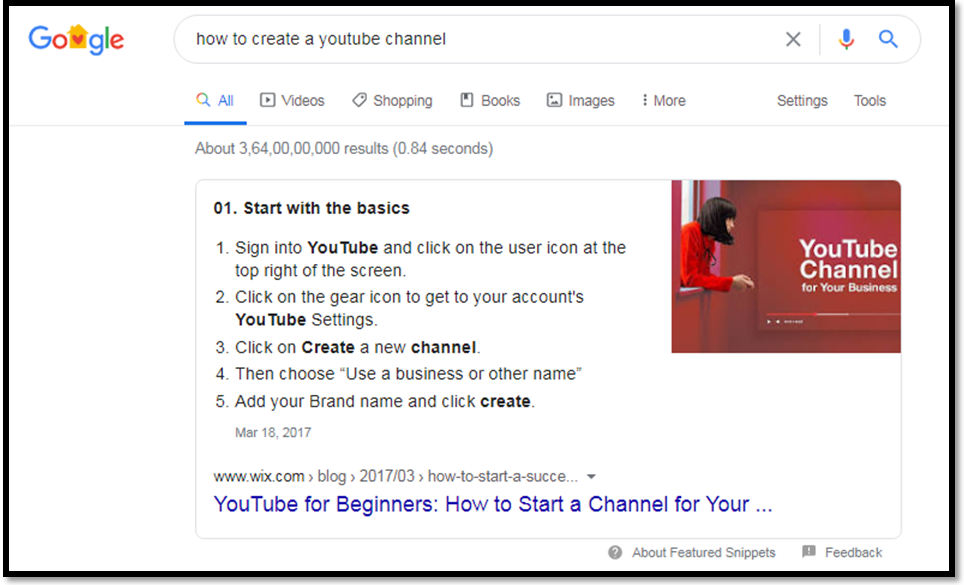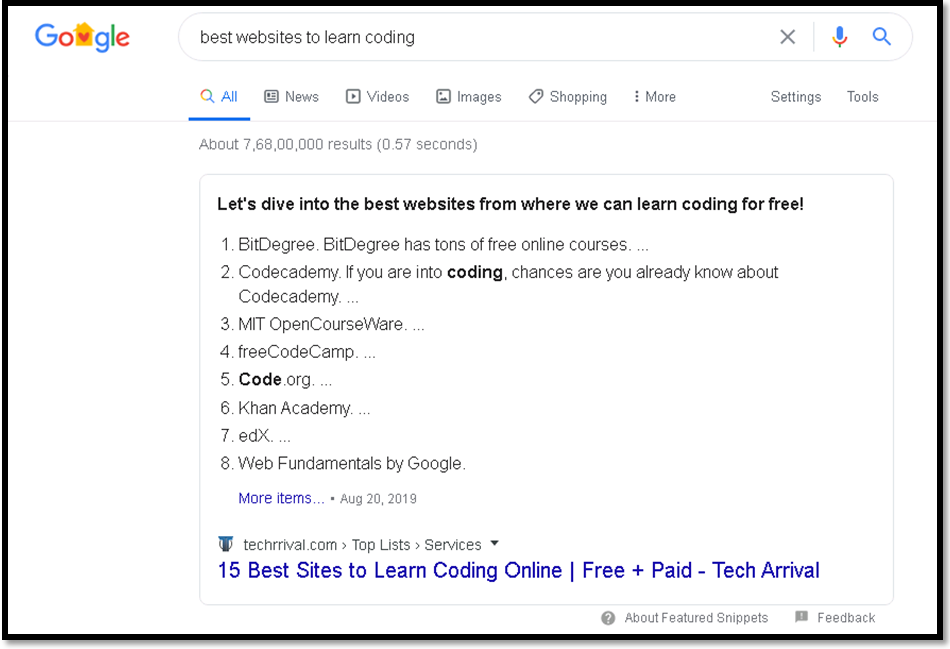-
Get Cloud GPU Server - Register Now!
Toggle navigation

As we embark on a new decade in 2020, we see businesses scrambling for the attention of their digital audience. With new SEO trends come to the fore every couple of months, businesses are trying every bit to stay relevant by incorporating these trends in their digital strategy.
Whether you are running a venture or working as a content marketer or SEO professional, you have to stay abreast of the latest SEO trends in 2020 if you want to enhance your commercial viability.
So, let us dive right in and see what these trends are.
Search engines are constantly improving their algorithms to deliver the most relevant answers to user queries. Elements such as Featured Snippets have a major role to play here.
For those who don’t know, featured snippets are short pieces of text that appear at the top of Google’s search results and provide direct, concise answers to user queries.
The content that appears in these Snippets is automatically pulled from the webpages indexed by Google.
Featured Snippets can be in the form of:


Featured Snippets offer an opportunity to get more clicks from organic search results, even when you are not ranking on top position.
Optimizing for featured snippets is easy-you need to provide clear, concise answers to frequently asked questions on your website.
Of course, you have to rank on page 1 to improve the odds of getting mentioned in Featured Snippets. 99% of the snippets are from pages that already rank on the first page of search results.
Introduced in 2018, featured snippets are now driving almost half of the search engine clicks.
So, if you are a content creator, jump on this bandwagon and amplify your brand visibility with a few minor changes in your content.
Consider the following statistics for a moment:
The above figures point to the rising popularity of voice searches.
Voice searches are growing by the day as people are seeking faster, better response to their queries. Besides, the increasing usage of mobiles and AI-based smart devices are also contributing to its growth.
Voice search isn’t exactly like text-based search. Voice changes how we search.
Typically voice search queries are longer and more conversational than a conventional text-based query.
Voice also changes how we get answers. In many instances, Google reads out the answer to you without requiring you to sift through several search results.
In order to make sure you do not miss out on opportunities in this space, there are a couple of things you can do:
Choose Conversational, Natural Language Keywords: The keywords for voice search are typically longer than conventional search keywords, usually 5 words or longer. In short, go for long-tailed keywords that sound more natural and human-like.
Choose Keywords that are Questions: Because a large percentage of voice queries are questions, you can target keywords that are queries asking the who, why, where, when, how or who of any topic. You can accordingly include short answers in your content. But these answers shouldn’t be longer than 29 words.
Optimize for Featured Snippets: This has already been discussed above.
Optimize for Local Searches: A large percentage of voice searches are ‘..near me’ searches where the user is looking for a local store/service. As a result, optimizing your content for local searches makes perfect sense.
Want to dig deeper into local search? Explore our comprehensive guide on local search: A Guide to Building a Local SEO Strategy in 2020

Among the latest SEO trends are videos.
Videos have become an integral part of the digital strategy of any business. Here are some statistics that testify to their indispensability:
So, there’s no denying that videos are the future of content. If you want to amplify your presence in the online space, videos have to be a crucial part of your content strategy.
But merely creating and publishing high-quality videos isn’t enough. You have to make sure your target audience can discover your videos.
Here are some SEO tips you can follow to optimize your videos for search engines:
Optimize the Title and Description of your Video: Do exhaustive keyword research to identify keywords people are searching for. Create a compelling title and description for your video content. Insert your keywords naturally in your title and description.
Insert a Transcript in your Video: Video transcript is the text that pairs with your video. Transcripts make your content more discoverable by search engine bots as they add more text to the page.
Create an Engaging Thumbnail: A video thumbnail is the main image users see when your video gets indexed. Unless your thumbnail is compelling and relevant, they may not click on your video.
While you can choose any of the thumbnail options auto-generated on YouTube, it is recommended to upload a customized thumbnail.
For thumbnails, choose images that are 1280 pixels wide and 720 pixels tall. The image should be in .jpg, .png, .gif, or.bmp formats. Any image heavier than 2 MB isn’t recommended.
Make Sure your Page is SEO-Optimized and Relevant to the Video: You cannot rely solely on video optimization to rank your video content in search engine rankings.
If your page isn’t optimized for the right keywords, search engines will not crawl it. So, you have to make sure you post high-quality content on your page and take care of the technical aspects of the SEO.
Besides, the video should be relevant to the page you are publishing it on. If the page is about online marketing and you throw a music video on it, chances of your video getting ranked are slim.
Categorize your Video on YouTube: By creating a category for your video, you can group it with similar videos on YouTube and make sure it appears in different playlists and gets exposed to a wider audience. ‘Advanced Settings’ on YouTube allow you to place your videos in the desired category.
For more information on video marketing, refer to our super-detailed guide on video marketing: A Must-Read Guide to Video Marketing in 2020.

Last year, mobile accounted for 52% of the traffic worldwide.
The rapid strides in technology over the past couple of years have spurred an exponential rise in the number of smartphones.
In 2019, Google enabled mobile-first indexing for all new websites. This means the search engine will predominantly use the mobile version of the website content for ranking and indexing.
So, if your website doesn’t have a mobile-friendly version, you may not be able to reach as many people as you want to. Mobile-friendly websites are need of the hour and businesses that do not work in this direction will miss on a big opportunity.
Here are a few things you can do to make your website mobile-friendly:
Choose a Responsive Theme on CMS: While this may not be a good option if you have an established website, it can be a quick fix for those with a new website.
If your website is built on WordPress CMS, you will have a lot of themes to choose from. Once you have installed the theme, make sure to check it looks fine on all the devices.
Keep Widths in Terms of Percentages: All HTML elements on a webpage have a width assigned to them. This width can be terms of pixels or percentage. If you assign width as, say 70% to an element, the browser will make that element 70% of the width of the screen-in order words, the element will shrink to fit the width of the screen.
With pixels, the width will not change as per the screen size. So, it’s recommended that you specify the width of all HTML elements as percentages and not as pixels.
Simplify Menus: While your desktop menu can afford to have lots of options, things change when it comes to your mobile screen. Because mobile users do not want to zoom in and view all the available menu options, it’s vital that you keep the menu on your mobile website as simple as possible.
Pay attention to the Placement of Clickable Elements: Clickable elements such as buttons should be placed towards the middle of the screen and should be large enough to be clicked with a finger. Ample space should be provided between buttons to prevent users from accidentally clicking on the wrong button.
Include a Search Function: Including a search function in your mobile website eliminates the need for a large and complex menu. Adding a search bar at the top of your webpage makes it easy for users to instantly find what they are looking for.
Avoid Large Chunks of Text: Large blocks of text are difficult to read especially on a mobile screen. Hence, it’s imperative that you keep the amount of text to a minimum. Keep your sentences and paragraphs as concise as possible.
Google search algorithms are getting better at giving results that match the intent of the user making the query. Google’s recent update BERT also focusses on the search intent of the user.
So, the better the content of your webpage matches the intent of the user query, the higher your page will rank in the search results.
Now, the easiest way to identify the intent of the user is to analyze the keyword itself.
For example, if the user types ‘what is paleo diet’, he is apparently looking for some information on this topic. He isn’t looking to buy anything. So, if the user comes across a webpage that is selling something related to the paleo diet, he may not click on it. And even if he clicks, he will exit the webpage soon.
Consider another keyword like ‘paleo diet courses’. Here the user is looking to make a transaction. In contrast, in a keyword such as ‘best paleo diet cookbooks’, the user is weighing the different alternatives before deciding to make a purchase. In each of these cases, the user will click and spend time on pages that match the intent of his query.
So, long story short-if your webpage is optimized for search intent of the user, it becomes easy to rank your page for that keyword.
6) User Experience Signals to Drive Ranking
In 2015, Google brought in an artificial intelligence algorithm ‘BrainRank’ to filter search results. Google, later on, confirmed that ‘BrainRank’ was among the top three ranking signals in its search algorithm.
The main job of this algorithm is to measure how users interact with search results i.e. to measure user satisfaction.
BrainRank pays special attention to the following user-experience signals while measuring user satisfaction:
If these signals are in the right direction, Google will boost the ranking of the search result page. Otherwise, it will bring it down.
For example, if the click-through rate of one of your landing pages is high, Google will move your page higher in the search results.
So, how can you optimize your webpage for BrainRank? Here are some of the steps you can take:
Optimize Title Tag and Meta Description for CTR: Write a compelling title and description for your page. Insert your targeted keyword naturally in both the title and description.
Include numbers and stats in your title for a better impact. Borrow ideas from paid ads-use words and phrases that they use regularly.
Optimize Content for Bounce Rate and Dwell Time: In order to reduce bounce rate and improve dwell time, take steps to optimize the content on your webpage.
Write content that’s in-depth, preferably 2000 words or longer. Long and in-depth content often satisfies a user query fully and makes a user stay longer on your page. Break your content into bite-sized pieces to improve its readability.

There’s no denying that online advertising has played a crucial role in driving the bottom-line of businesses. But online ads are expensive to run. Besides, they may not yield the desired results always.
For these reasons, producing high-quality content on a consistent basis has become more important than ever before.
People come to Google to get their queries answered. They need content that’s relevant, engaging and timely. Google rewards pages that deliver such kind of content with higher search engine rankings.
Google Webmaster has published some guidelines enlisting the practices you should and shouldn’t follow while publishing content. Some of these practices are as follows:
In 2020 and beyond, users will seek high-quality content that’s well-researched and easy to navigate and read. With so many options out there, users will stay away from content that’s overly promotional, shallow or simply does not fulfill their needs.
2020 will witness brands competing even more fiercely to grab the coveted top position in Google searches. Brands staying abreast of the latest in the SEO space will evidently have an edge provided they act well in time.
Need more such articles on SEO? If yes, let us know in the comment section below. Thanks for reading.